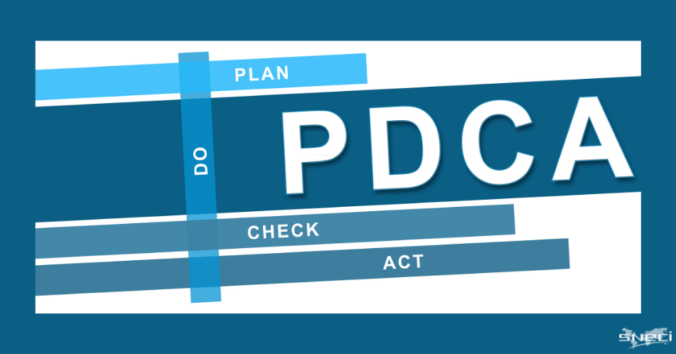The PDCA Method: ideal for the continuous improvement of your activities

The PDCA method, also known as “Deming’s Wheel” is a process used by organizations in the context of continuous improvement. Invented by the American researcher William Edwards Deming in the 1950s, the goal of this tool is to improve the performance of the company while solving the problems it faces. The proposed process is not limited to one type of problem but can be applied to many situations. The PDCA method is considered an improvement method derived from Lean Management.
The PDCA method: based on a virtuous circle
The PDCA tool “Plan, Do, Check, Act” is a virtuous cycle that must be repeated in order to remain in the continuous improvement process. This process makes it possible to improve the quality of the company’s products and services and can be applied to all of its functions. It will allow to solve the problems encountered thanks to 4 key steps.
Step 1: Plan or Schedule
It consists of taking stock and analyzing the current situation. This includes identifying the problems encountered and defining the objectives to be achieved. The planning stage must include different key elements:
- Identify the problems to be solved as well as their cause and origin
- Identify the consequences of the problems on the organization’s performance
- Define the objectives to be achieved
- Identify the external and internal actors involved in the project(s)
- Identify the current work methods and the global work environment
- Identify possible solutions to the problems
- Identify the resources (human, material, technological) needed to solve the problems and achieve the objectives
- Select and choose the most appropriate solution(s) to solve your problems, taking into account your constraints
Once these steps have been completed (in the order you deem most effective), you can move on to the next step in the process.
Step 2: Do or Deploy
It is now time to take action based on what has been identified and determined in step 1. It is about putting into practice the chosen method(s).
There are several steps to this phase:
- Application of the selected methods
- Readjustment of the methods if necessary
- Identification of the most relevant methods
It is important to keep in mind that it is not a question of solving all the problems at once, but rather to favour small successive changes. The first step is to implement the plan on a small scale to ensure that it works.
In fact, this step should be seen as an “experiment” and should be done on a small scale. It would be inappropriate to strive for perfection during this phase, but rather it should be used to distinguish between methods that work best and those that work less well.
Step 3: Check
Once the action plan has been implemented, it is now time to measure the results obtained. This phase will allow to evaluate the efficiency of the measures implemented during step 2.
It will also allow you to understand any gaps between the objectives set and the results obtained. After studying the results, you will be able to determine whether or not the previous procedures should be generalized. If the results obtained are unsatisfactory, you will have to learn from them in order to readjust the action plan. This step is also the ideal moment to measure whether the overall efficiency of the project has been improved or not.
Thanks to the results obtained and your own analysis of them, all that remains to be done is to determine the final processes to be adopted.
Step 4: Act
This is the last phase of the PDCA method. It corresponds to the deployment phase of your action plan. It will now be necessary to extend and apply it to the entire defined perimeter:
- Drafting of (new) processes
- Organization of the (new) processes
- Selection and implementation of the most relevant changes
- Explaining and assigning tasks to the different actors to implement the planned changes
- Set up a regular follow-up of the performance of the implemented processes
The objective of this step is also to ensure the effectiveness of the processes over the long term. If the action plan has not achieved the desired results, we can then restart a PDCA cycle and adapt our processes according to the new points of improvement identified.
The advantages of the PDCA method
- The PDCA method is particularly flexible: it is not limited to a single type of context. It is applicable to a multitude of situations.
- This process is rather simple to understand and implement: the implementation of its 4 principles is within everyone’s reach, provided that one is rigorous and well organized.
- The PDCA tool also helps improve productivity by improving performance within the organization.
- It is a very useful process to test on a small scale the action plan and the changes we plan to implement. Thus, it allows us to determine which methods will eventually be deployed and which ones will not.
- The PDCA method works like a cycle, which allows us to be in a continuous improvement process.
SNECI supports you in Lean Manufacturing
The PDCA method, based on Lean Management, will allow you to improve your productivity and the performance of your organization. There are also other tools and methods such as the Poka-Yoke allowing for continuous improvement of your activity. SNECI supports you at every stage.
With 70 years of experience in improving industrial performance, with strong roots in the automotive, defense, healthcare, rail, luxury and energy industries, and with more than 450 experts worldwide in more than 50 countries, SNECI supports manufacturers and suppliers in implementing a Lean Management approach to increase their productivity and profitability.
More concretely, our experts accompany you in a detailed analysis of the different steps that make up your production process, and then we set up a convergence plan that helps you eliminate all the waste identified throughout the manufacturing process in order to be more efficient and more profitable, but above all, more competitive at the international level.
If you would like one of our industrial project managers to accompany you in improving your processes for greater profitability (saving time, money and efficiency), send an email to Laura who will reply within 24hrs to arrange a meeting at laura@sneci.com or directly via the contact tab on our website.





